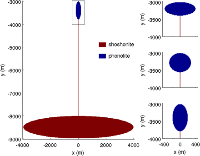Timescales of mingling in shallow magmatic reservoirs
Montagna C.P., P. Papale, A. Longo (2015). Timescales of mingling in shallow magmatic reservoirs, In: Caricchi L. \& Blundy, J. D. (eds) “Chemical, Physical and Temporal Evolution of Magmatic Systems”, Geological Society, London, Special Publications, 422, 6, 131-140, doi:10.1144/SP422.6
Abstract
Arrival of magma from depth into shallow reservoirs has been documented as one of the possible processes leading to eruption. Magma intruding and rising to the surface interacts with the already emplaced, degassed magmas residing at shallower depths, leaving chemical signatures in the erupted products.
We performed two-dimensional numerical simulations of the arrival of gas-rich magmas into shallow reservoirs. We solve the fluid dynamics for the two interacting magmas, evaluating the space–time evolution of the physical properties of the mixture.
Convection and mingling develop quickly into the chamber and feeding conduit/dyke, leading on longer timescales to a density stratification with the lighter, gas-richer magma, mixed with different proportions of the resident magma, rising to the top of the chamber due to buoyancy. Over timescales of hours, the magmas in the reservoir appear to have mingled throughout, and convective patterns become harder to identify.
Our simulations have been performed changing the geometry of the shallow reservoir and the gas content of the initial end-member magmas. Horizontally elongated magma chambers, as well as higher density contrasts between the two magmas, cause faster ascent velocities and also increase the mixing efficiency.


